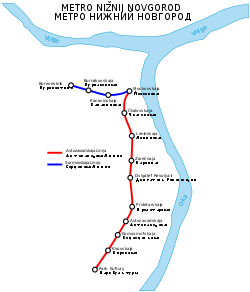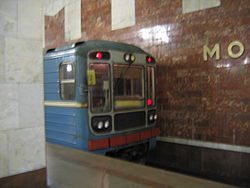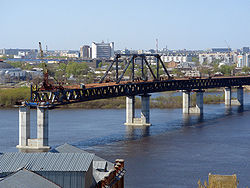- Nizhny Novgorod Metro
-
Nizhny Novgorod Metro
Нижегородский метрополитен
Nizhegorodsky metropolitenInfo Locale Nizhny Novgorod Transit type Rapid transit Number of lines 2 Number of stations 13 Operation Began operation 1985 Technical System map The Nizhny Novgorod Metro (Russian: Нижегородское метро), formerly known as Gorky Metro (Russian: Горьковское Метро) is a rapid-transit system that serves the city of Nizhny Novgorod, Russia. Opened in 1985, it consists of 13 stations and is 15.3 kilometres long.
Contents
History
Nizhny Novgorod (known in the Soviet times as Gorky) is a large city on the middle Volga. In the mid 1970s the population of the place exceeded a million thus meeting the Soviet requirements to develop a rapid-transit system. Construction began on December 17, 1977 and the network was opened to the public on November 20, 1985 becoming the third such system in Russia, and the tenth in the former Soviet Union.
Unlike other Soviet time Metros, Nizhny Novgrod does not feature the traditional triangle layout of three line, six radii intersecting under city centre. This is because of the unusual layout of the city. Nizhny Novgorod is located on the right bank of the Volga River, and at the confluence of the Oka River.
Over the 20th century, the city developed in a polycentric manner. The historical city centre, including the Nizhny Novgorod Kremlin bears most of administrative, cultural and educational functions and is located on the high hilly right bank of the Oka, whilst the low flat left bank hosts city's most industries and some major residential districts grouped around the three centers in Kanavino (where the city's central railway station and the largest urban transport hubs are located), Sormovo (with the largest industry being the Krasnoye Sormovo plant) and Avtozavod (GAZ).
Faced with such a physical dislocation, the planners adopted a design that would feature two lines with four radii opened in a series of stages (and each stage in segments). The main hub of the system, the Moskovskaya Station, located next to Nizhny Novgorod's main railway station, would feature a four track two island platform arrangement offering a cross-platform transfer. The first stage would be Avtozavodskaya Line, following south along the left bank of the Oka, through residential and industrial zones of Leninsky district, the massive GAZ automobile plant and into the Avtozavod residential districts. The second stage would be the Sormovskaya Line which would go from Moskovskaya west into the Sormovo districts. The third stage would feature a combined auto and Metro bridge across the Oka taking the Avtozavodskaya into the city centre, and the fourth and final stage would be the Sormovskaya passing into the Meshcherskoye Ozero residential area north-west of the Railway station, on the bank of the Volga. All of this would be finished by the late 1990s and the system would be a total of 25 kilometres long with above 20 stations.
The order in which the stages was opened was influenced by the industry-centric flows of passengers of the Soviet period, and the depot placement issue. Cross-river traffic used not to be as intense as it is today. GAZ was not only the dominating employer of the Avtozavodsky district, but also consumed a lot of workforce from the Northern parts of the city. The only suitable plot for the train depot was found near the automobile plant, too.
Whilst the pace of Metro construction in the Soviet Union was impressive, it did not, and could not foresee the events that would happen when the Soviet Union dissolved and how the financial and social implications would make the Nizhny Novgorod Metro a system with a very difficult future. So, when the first stage was completed in 1989, construction began on the second one...and that was the state in which the Gorky Metro embraced the 1990s.
The dissolution of the Soviet Union had devastating effects on the economy and people's lives. Aided with a hyperinflation, almost all funding of expansion of Metros, save Moscow and Saint Petersburg was cut. Those segments that did open in the early 1990s were mostly completed already and the bankrupt companies and workers struggled to finish them off. In late 1993 the first two station segment of the Sormovskaya Line was opened in Nizhny Novgorod.
Timeline
Segment Date opened Length Moskovskaya-Proletarskaya November 20, 1985 7.8 km Proletarskaya - Komsomolskaya August 8, 1987 2.4 km Komsomolskaya-Park Kultury November 15, 1989 2.2 km Moskovskaya-Burnakovskaya December 20, 1993 2.6 km Burnakovskaya-Burevestnik September 9, 2002 1.3 km Total: 13 stations 15.3 km Operation
Nizhny Novgorod Metro Sennaya Opernyy teatr Yarmarka Gorkovskaya Moskovskaya Moskovskaya Kanavinskaya Chkalovskaya Burnakovskaya 
Leninskaya Burevestnik 

Zarechnaya Varya Dvigatel Revolyutsii Sormovskaya Proletarskaya Avtozavodskaya Komsomolskaya Kirovskaya 
Park Kultury edit The Nizhny Novgorod Metro has an unusual operation. Formally it consists of two lines and 14 stations. However as Moskovskaya is a terminus for both of them, the trains arriving from one line continue into the other. Only two of the four tracks on Moskovskaya are in regular use, thus making sense to class it as a single station instead of two.
All but one of the thirteen stations are underground, and all are shallow level designs. Moskovskaya is the former USSR's unique pillar-fivespan, Chkalovskaya, Leninskaya, Park Kultury and Kanaviskaya are the standard single-vaults, and the rest are the standard pillar-trispans. The station Burevestnik is an exception as it is a surface station with side-platform layout.
The rolling stock of the Metro is provided by the Proletarskoye depot and a total of 80 81-717/714 models are in use. The length of each train is four cars long. Thus formally it is possible to make 20 trains, however there are never that many in operation, and the train interval is about 7½–8 min long in midday.
Future
More than a decade and half later, little has changed for the Nizhny Novgorod Metro and now it faces the grimmest fate of expansion. The biggest problem is that despite being the longest of its "new" Russian Metro rivals (new refers to Novosibirsk, Samara and Yekaterinburg) it has a passenger traffic that is one of the lowest - 16.8 million annual ridership in 2004. For comparison, the Novosibirsk system is almost double that.
The root of this problem is not the layout but the Soviet priorities on stage openings, over the past decade, the new Russian population's social structure greatly changed. Many chose to abandon the factories and, particularly the younger generation, in favour of a career in commerce. For Nizhny Novgorod this had a great effect on the daily transport pattern, where the city centre became a nexus for the region's business. Many agree that it was a grave mistake not to link up the two banks of the Oka river prior to continuing the expansion into the residential districts.
Indeed at present the necessity of the Metro on the right bank is felt, as all the three bridges that connect the land transport routes are over congested. More disturbing is the fear that the first station on the right bank — Gorkovskaya would, if opened, not be able to deal with the massive passenger traffic, meaning that the right bank will have to open with several stations. For the other direction of the Metro — Sormovoskaya Line is also a mess. Neither the first segment of the line, nor its one extension to a surface station — Burevestnik actually reach Sormovo proper and ends amid an industrial zone. Many commuters thus choose not to use the Metro altogether as they would be forced to switch to land transport anyway.
Thus the only single transport artery that the Metro provides is the Avtozavodskaya Line, which apart from the terminus stations, is known for its very gloomy appearance due to the lighting being mostly off to cut electricity costs. Construction of Metrobridge began in 1995, but its pace has been very slow. The northern extension of the Sormovskaya Line began at the same time when the station pit was dug up for the future Yarmarka station, but since it has been disbanded and covered up.
Nonetheless, despite such pessimism, many in Nizhny Novgorod believe that sooner or later there will be a major breakthrough in the deadlock. The recent example of the Kazan Metro is the cause of optimism. When faced with the deadline for the city's millennium anniversary, Metro brigades from Russia and the CIS joined to help complete the system for the opening. Given the need for the Metro in Nizhny Novgorod, sooner or later such a drastic helping hand would come. In fact the first signs are already showing when in the federal budget of 2006, the financing of the construction in Nizhny Novgorod doubled from 77.1 million rubles to 158.8 [1]. Although most of it (100 million) was directed towards the Metro bridge, nonetheless even that is welcome news, and indeed the pace of construction of the bridge has drastically increased over the past two years. In addition it was chosen to use part of the surface railway's tracks for completion of the Sormovskaya Line.
Accordingly to current (as of 2011) forecasts, the Avtozavodskaya Line will finally open in November 2012 [1], allowing the Nizhny Novgorod Metro to finally become the transport artery that it was designed to be.
See also
References
- ^ Transport Rossii - 2006 federal budget for Metro construction - Retrieved on 28 January, 2007
External links
- (English) Urbanrail.net
- (Russian) Metroworld site - Extensive information
- (Russian) Metrowalks - Extensive image collection and station description
- (English) Nizhny Novgorod Metro Travel and business guide to Nizhny Novgorod
Rapid transit in the former Soviet Union Metros* Moscow · St. Petersburg · Kiev · Tbilisi · Baku · Kharkiv · Tashkent · Yerevan · Minsk · Nizhny Novgorod · Novosibirsk · Samara · Yekaterinburg · Dnipropetrovsk · KazanMetrotrams Monorail Cave railroad Under construction Planned Abandoned * Listed in order of opening.Categories:- Rapid transit in Russia
- Nizhny Novgorod
- Railway lines opened in 1985
Wikimedia Foundation. 2010.



